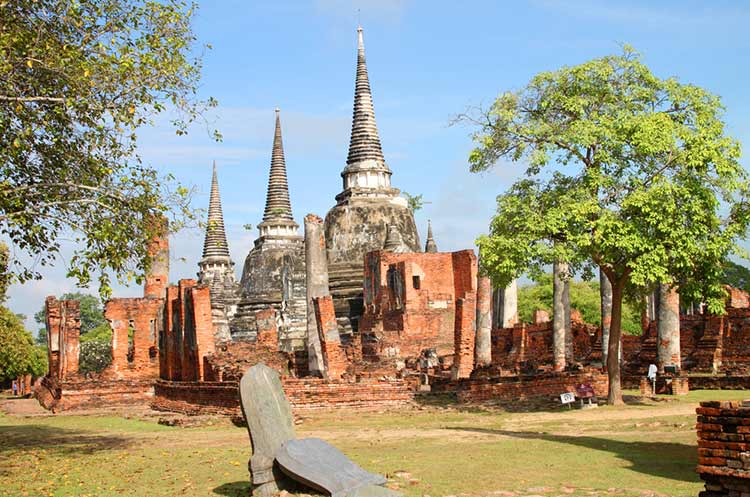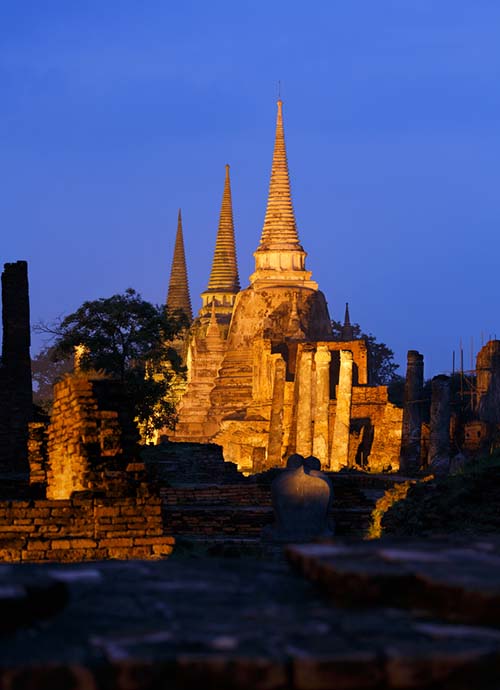
Wat Phra Si Sanphet
“The temple of the Buddha Si Sanphet”
Wat Phra Si Sanphet, “the temple of the Buddha Si Sanphet” was the most important temple in the Ayutthaya Kingdom. Being part of the Royal Palace complex, the very large monastery with dozens of structures was used by Ayutthaya Kings only; it was a Royal temple without resident monks.
In its heydays mid 17th century the temple consisted of a raised platform supporting three very large gilded bell shaped stupas and three gilded mondops, an enormous viharn enshrining a 16 meter tall gilded Buddha image, as well as dozens of smaller chedis and chapels.
Architecture of the Wat Phra Si Sanphet
The monastery’s main structures are aligned East West. At the center of the Wat Phra Si Sanphet are three large bell shaped stupas (chedis) standing on an elevated platform. Next to each chedi stood a square mondop with a pyramidal roof.
The platform is surrounded by a walled and roofed gallery lined with Buddha images. East stands the massive principal viharn that enshrined the 16 meter tall gilded Phra Si Sanphet Buddha as well as two smaller viharns.
Near the East wall are an ordination hall and the Sala Chom Thong, the hall were monks studied the teachings of the Buddha.
The complex is surrounded by an outer wall with access gates at each of the cardinal directions. Lining the walls is a great number of subsidiary chedis and viharns.
History of the Wat Phra Si Sanphet
The history of the Wat Phra Si Sanphet spans several centuries. The first structures were built during the 14th century. During the reign of later Ayutthaya Kings structures were added until the temple reached the peak of its glory in the second half of the 17th century.
It starts halfway the 14th century when U Thong, first King of Ayutthaya, built several chedis on the site near the Royal palace. When King Borommatrailokkanat ordered a new palace built in 1448, he converted the old palace into a Royal monastery.
In 1491 King Ramathibodi II built two large chedis to enshrine the ashes of his father and older brother. Several years later the King had a 50 meter long viharn built East of the chedis to enshrine a large gilded image of the Buddha named Phra Si Sanphet. The temple then got its present name.
Another three decades later a third chedi was constructed to enshrine the ashes of King Ramathibodi II. During the reign of King Narai in the second half of the 17th century a large cross shaped viharn named Prasat Phra Narai was constructed directly West of the central platform supporting the three stupas.
The temple was largely destroyed by the Burmese armies in 1767, leaving only its three massive stupas standing.

Three main stupas
At the center of Wat Phra Si Sanphet are three very large bell shaped stupas, that were once gilded. At each of the four cardinal directions is a porch protruding out from the structure. A niche enshrined a standing image of the Buddha. In the core of each stupa was a small chamber where the ashes of Ayutthaya Kings were enshrined.
Next to each stupa stood a mondop (mandapa), a building with a square floor plan and pyramidal roof. Today only their base remains. The mondops probably enshrined highly revered images of the Buddha.
The central platform supporting the stupas is surrounded by galleries lined with Buddha images in subduing Mara posture, also known as Calling the Earth to witness.
Relics discovered in the East chedi
During excavation works in the Eastern most chedi the Fine Arts Department discovered a series of miniature stupas, each one enclosing a smaller one. The most inner one contained relics. The miniature relics stupas are exhibited at the Chao Sam Phraya National Museum.
16 Meter gilded Phra Si Sanphet image
The Wat Phra Si Sanphet housed an enormous gilded image of the Buddha, which must have been one of the Kingdom’s most beautiful.
The 16 meter tall standing image covered with over 340 kilos of gold was enshrined in the Viharn Luang, the Royal assembly hall. Also called Viharn Phra Si Sanphet after the image, the hall measures 50 meters long. Today its foundation and sections of its walls remain as well as a large alter to the back of the hall upon which the Phra Si Sanphet image once stood.
The heavily gilded Phra Si Sanphet Buddha image was not spared during the Burmese invasion of 1767. Its gold was melted down and taken to Burma. The remaining bronze core was taken to Bangkok where it was restored and enshrined in a chedi of the Wat Pho.
Prasat Phra Narai
During the reign of King Narai in the second half of the 17th century a large cross shaped viharn named Prasat Phra Narai was constructed West of the central platform. Large sections of its walls with its arched windows are still standing today.
The ordination hall
Near the Viharn Luang stands the Wat Phra Si Sanphet’s large ubosot, the hall where novices were ordained into monkhood. Its beautifully carved wooden door panels showing depictions of guardians survived the destruction of 1767. They are exhibited at the Chao Sam Phraya National Museum. Eight sema stones surrounding the hall mark the sacred area.
Sala Chom Thong
Near the South East corner of the complex stands the well preserved Sala Chom Thong, the hall where monks studied the Tripitaka, the Buddhist teachings. Its high walls and two rows of pillars that supported the roof are still standing. To the back of the hall are the remains of a pedestal where a Buddha image once sat.
Opening hours
The monastery opens daily from 8 am until 5 pm.
Entrance fees
Admission is 50 Baht.
- Wat Mahathat
- Wat Chaiwatthanaram
- Wat Ratchaburana
- Wat Phanan Choeng
- Wat Lokaya Sutha
- Wat Yai Chai Mongkhon
Ayutthaya Historical Park Tours
- From Bangkok
- Private or group tour
- Also visit other highlights like Bang Pa-In Summer Palace